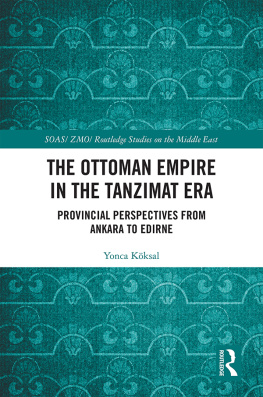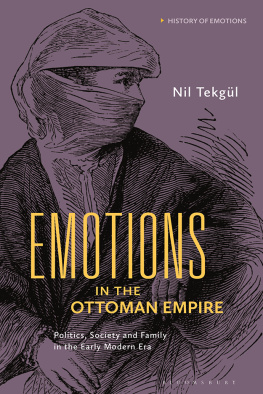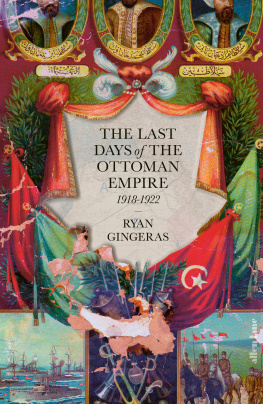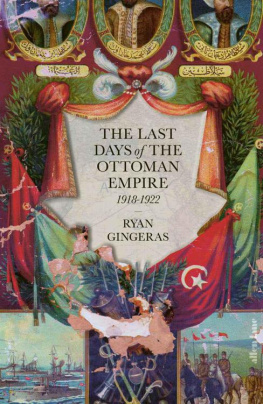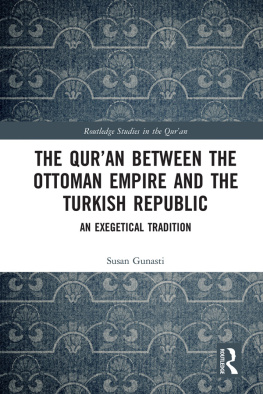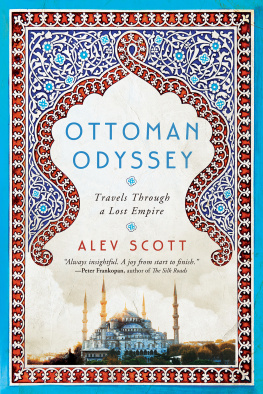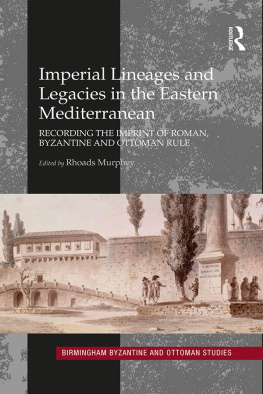About the Author
Selcuk Aksin Somel (B.A., Faculty of Political Sciences, Ankara University; M.A., History Department, Boazii University; Ph.D., Department of Turkish Studies, Bamberg University) is assistant professor of Ottoman history in the Faculty of Arts and Social Sciences at Sabanci University, Istanbul. He is an expert on nineteenth-century Ottoman education, focusing his research on peripheral populations (tribes, heterodox religious communities, Crypto-Christians), gender history (female education, abortion), legitimacy and power (state authority, Islamization, and social disciplining), the modernization of central bureaucracy, and the development of statistics. Between 1993 and 1998 he acted as chairman of the Department of History at Bilkent University. He is a corresponding member of the Turkish Historical Association and a member of the Foundation of Economic and Social History of Turkey, as well as of the Middle East Studies Association of North America. His publications include The Modernization of Public Education in the Ottoman Empire, 18391908 , published in 2001.
Acknowledgments
This volume took shape with the valuable and very helpful criticism of Oktay zel, Mehmet Kalpakl, and Cadoc Douglas Leighton. In addition, Cadoc Leighton went to the trouble of revising most of the dictionary. I am grateful to him for his efforts. Finally, David Thornton, Slobodan Ili, and Nebahat ksz did much to create a stimulating atmosphere for the completion of this work. I am equally indebted to them.
Selected Bibliography
INTRODUCTION
Ottoman historiography today involves numerous countries in the eastern Mediterranean Basin, as a consequence of the broad historical presence of the Ottoman Empire. To the extent that countries acknowledge Ottoman history as an integral part of their national past, one observes a proliferation of academic studies in this vast field. In this respect the Balkan countries, especially Bulgaria and former Yugoslavia (Serbia, Bosnia, and Macedonia), Hungary, and to some extent also Israel, are noteworthy. Historians from Turkey, on the other hand, concentrate their efforts mainly on Anatolia. This historiographic distribution reflects the main bibliographic sources of Ottoman studies, which are published mainly in Turkish, English (in Israel), Bulgarian, and Serbo-Croatian. French and German are also used in numerous academic publications in the Balkans and in Hungary.
As for Western countries, Austria, Germany, and France traditionally led research in Ottoman history. Since the 1970s, however, a growing interest in Ottoman history has manifested itself in the Anglo-Saxon world. In fact, at present the majority of Western research literature originates from the United States.
Due to this historiographical situation, there is a variety of national and regional bibliographies embracing a rich literature on Ottoman history. But students approaching the subject for the first time would do best to begin with two basic bibliographies. One of them is the Index Islamicus (1958, 1972, 1975, 1989, 1993, 1999), which includes historical literature from 1665 until the present. Though this bibliography covers the whole Muslim world, an important part of it includes Ottoman history; the major weakness of this index is its emphasis on sources in European languages (English, French, German, and Russian). The other bibliography is the Turkology Annual/Trkologischer Anzeiger (1975). This is a fundamental source for publications concerning Ottoman, Turkish, and Turkic culture and history; it includes publications mainly in European and Balkan languages, Turkish and Turkic languages, Arabic, and Hebrew. In addition to these two basic bibliographies, historical literature on Ottoman Europe has been published by H. J. Kornrumpf ( Osmanische Bibliographie mit besonderer Bercksichtigung der Trkei in Europa , 1973) and K. Kreiser ( Historische Bcherkunde Sdosteuropas, vol. 2: Neuzeit: Teil I. Osmanisches Reich, Makedonien, Albanien, 1988).
For those able to read Turkish (and Ottoman Turkish), Enver Korays Trkiye Tarih Yaynlar Bibliyografyas, 17291984 (1987) [bibliography on Turkish publications on history, 17291984]; Seyfeddin zeges catalogue of Ottoman book titles ( Eski Harflerle Baslm Trke Eserler Katalou, 197182); and Hasan Dumans Union Catalogue of the Periodicals in Arabic Script in the Libraries of Istanbul (1986) must be consulted. For the most recent publications, the Turkish national bibliography (Trkiye Bibliyografyas) and the Turkish national bibliography of articles (Trkiye Makaleler Bibliyografyas), both published by Turkish National Library, are the main references.
The main Ottoman archives are located in stanbul and in Ankara ( see Archives ). Major manuscript collections in stanbul are at the Topkap Palace Library, the Sleymaniyye Library, the stanbul University Library, the Beyazt State Library, the Atatrk Library, and the Millet Library. In Ankara, the Turkish National Library, the Ankara University Faculty of Arts Library, the Turkish Language Society Library, and the Turkish Historical Society Library contain major collections. In Konya, the Mevlana Museum Library, the Yusuf Aa Library, and the Koyunolu Museum Library host large collections of Turkish and Islamic manuscripts. The provincial libraries of Adana, Bursa, Kayseri, Edirne, Diyarbakr, Manisa, Akhisar, and other towns have local manuscript collections.
Outside the modern Turkish borders, perhaps the most important Ottoman archival collection is located in the Bulgarian National Library, Sofia. This collection covers all periods of Ottoman history, from its beginnings until 1878. Another noteworthy collection of Ottoman documents is preserved in the government library of Dubrovnik, Croatia. This collection, still awaiting exploitation, promises to provide extensive documentation on Ottoman trade relations with Europe. Otherwise, most of the present capitals of former imperial territories contain collections of Ottoman documents, preserved mainly in the respective national libraries. The collections in the Balkan countries are generally open to outside researchers. For the Middle East, this is true only for Israel.
As for collections of Ottoman materials in Western libraries, Turkish manuscripts in Great Britain are located mainly in London, at the Department of Oriental Manuscripts and Printed Books at the British Library. Others are kept in the libraries of the School of Oriental and African Studies of the University of London, the John Rylands Library of the University of Manchester, and Bodleian Library at Oxford. In France, the Bibliothque Nationale preserves an important collection of Turkish manuscripts. The vast majority of Ottoman materials in Germany are located in the Staatsbibliothek Preussischer Kulturbesitz, Berlin. Few others can be found in the university libraries of Leipzig, Dresden, Halle, and Jena and in the Bibliothek der Deutschen Morgenlndischen Gesellschaft in Halle. In Austria, the Austrian National Library (former Imperial and Royal Court Library) contains a large collection of Ottoman manuscripts. The Leiden University Library in the Netherlands has one of the main Turkish manuscript collections in Europe.
In the United States, the main Turkish archival collections are located in the Research Library of the University of California, Los Angeles; the Hoover Collections at Stanford University, Palo Alto, California; the Yale University Library; the Princeton University Library; the University of Michigan Library; and the Columbia University Libraries.
The discipline of Ottoman history is still in its infancy, as evidenced by the fact that the classification of documents in the Prime Minister-ial Ottoman Archive in stanbul is still not complete. Yet there is a certain concentration of academic studies in terms of Ottoman historical periods, a tendency that is clearly visible for the Classical Period and the Reform Period. On the other hand, the early Ottoman history, as well as the seventeenth and eighteenth centuries, have been comparatively less researched. This general state of research manifests itself in the selected bibliography of this dictionary, in terms of its strengths and weaknesses.


